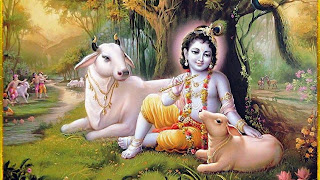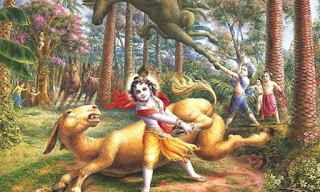krishna leela and story of sri lord krishna
The name "Krishna" originates from the Sanskrit word Kṛṣṇa, which is primarily an adjective meaning "black", "dark", or "dark blue". The waning moon is called Krishna Paksha, relating to the adjective meaning "darkening". The name is also interpreted sometimes as "all-attractive"
As a name of Vishnu, Krishna is listed as the 57th name in the Vishnu Sahasranama. Based on his name, Krishna is often depicted in idols as black- or blue-skinned. Krishna is also known by various other names, epithets, and titles that reflect his many associations and attributes. Among the most common names are Mohan "enchanter"; Govinda "chief herdsman", and Gopala "Protector of the 'Go'", which means "Soul" or "the cows".Some names for Krishna hold regional importance; Jagannatha, found in Puri Hindu temple, is a popular incarnation in Odisha state and nearby regions of eastern India
Krishna is represented in the Indian traditions in many ways, but with some common features. His iconography typically depicts him with black, dark, or blue skin, like Vishnu. However, ancient and medieval reliefs and stone-based arts depict him in the natural color of the material out of which he is formed, both in India and in southeast Asia.In some texts, his skin is poetically described as the color of Jambul (Jamun, a purple-colored fruit).
Krishna is often depicted wearing a peacock-feather wreath or crown, and playing the bansuri (Indian flute). In this form, he is usually shown standing with one leg bent in front of the other in the Tribhanga posture. He is sometimes accompanied by cows or a calf, which symbolise the divine herdsman Govinda. Alternatively, he is shown as a romantic and seductive man with the gopis (milkmaids), often making music or playing pranks
Krishna lifting Govardhana at Bharat Kala Bhavan, recovered from a Muslim graveyard in Varanasi. It is dated to the Gupta Empire era (4th/6th-century CE).
In other icons, he is a part of battlefield scenes of the epic Mahabharata. He is shown as a charioteer, notably when he is addressing the Pandava prince Arjuna character, symbolically reflecting the events that led to the Bhagavad Gita – a scripture of Hinduism. In these popular depictions, Krishna appears in the front as the charioteer, either as a counsel listening to Arjuna, or as the driver of the chariot while Arjuna aims his arrows in the battlefield of Kurukshetra
Alternate icons of Krishna show him as a baby (Bala Krishna, the child Krishna), a toddler crawling on his hands and knees, a dancing child, or an innocent-looking child playfully stealing or consuming butter (Makkan Chor), holding Laddu in his hand (Laddu Gopal] or as a cosmic infant sucking his toe while floating on a banyan leaf during the Pralaya (the cosmic dissolution) observed by sage Markandeya.Regional variations in the iconography of Krishna are seen in his different forms, such as Jaganatha in Odisha, Vithoba in Maharashtra, Shrinathji in Rajasthan and Guruvayoorappan in Kerala
Guidelines for the preparation of Krishna icons in design and architecture are described in medieval-era Sanskrit texts on Hindu temple arts such as Vaikhanasa agama, Vishnu dharmottara, Brihat samhita, and Agni Purana.Similarly, early medieval-era Tamil texts also contain guidelines for sculpting Krishna and Rukmini. Several statues made according to these guidelines are in the collections of the Government Museum, Chennai
As a name of Vishnu, Krishna is listed as the 57th name in the Vishnu Sahasranama. Based on his name, Krishna is often depicted in idols as black- or blue-skinned. Krishna is also known by various other names, epithets, and titles that reflect his many associations and attributes. Among the most common names are Mohan "enchanter"; Govinda "chief herdsman", and Gopala "Protector of the 'Go'", which means "Soul" or "the cows".Some names for Krishna hold regional importance; Jagannatha, found in Puri Hindu temple, is a popular incarnation in Odisha state and nearby regions of eastern India
Krishna is represented in the Indian traditions in many ways, but with some common features. His iconography typically depicts him with black, dark, or blue skin, like Vishnu. However, ancient and medieval reliefs and stone-based arts depict him in the natural color of the material out of which he is formed, both in India and in southeast Asia.In some texts, his skin is poetically described as the color of Jambul (Jamun, a purple-colored fruit).
Krishna is often depicted wearing a peacock-feather wreath or crown, and playing the bansuri (Indian flute). In this form, he is usually shown standing with one leg bent in front of the other in the Tribhanga posture. He is sometimes accompanied by cows or a calf, which symbolise the divine herdsman Govinda. Alternatively, he is shown as a romantic and seductive man with the gopis (milkmaids), often making music or playing pranks
Krishna lifting Govardhana at Bharat Kala Bhavan, recovered from a Muslim graveyard in Varanasi. It is dated to the Gupta Empire era (4th/6th-century CE).
In other icons, he is a part of battlefield scenes of the epic Mahabharata. He is shown as a charioteer, notably when he is addressing the Pandava prince Arjuna character, symbolically reflecting the events that led to the Bhagavad Gita – a scripture of Hinduism. In these popular depictions, Krishna appears in the front as the charioteer, either as a counsel listening to Arjuna, or as the driver of the chariot while Arjuna aims his arrows in the battlefield of Kurukshetra
Alternate icons of Krishna show him as a baby (Bala Krishna, the child Krishna), a toddler crawling on his hands and knees, a dancing child, or an innocent-looking child playfully stealing or consuming butter (Makkan Chor), holding Laddu in his hand (Laddu Gopal] or as a cosmic infant sucking his toe while floating on a banyan leaf during the Pralaya (the cosmic dissolution) observed by sage Markandeya.Regional variations in the iconography of Krishna are seen in his different forms, such as Jaganatha in Odisha, Vithoba in Maharashtra, Shrinathji in Rajasthan and Guruvayoorappan in Kerala
Guidelines for the preparation of Krishna icons in design and architecture are described in medieval-era Sanskrit texts on Hindu temple arts such as Vaikhanasa agama, Vishnu dharmottara, Brihat samhita, and Agni Purana.Similarly, early medieval-era Tamil texts also contain guidelines for sculpting Krishna and Rukmini. Several statues made according to these guidelines are in the collections of the Government Museum, Chennai




Comments
Post a Comment